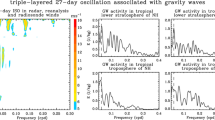Abstract
Characteristics of the Arctic Oscillation and El Niño-Southern Oscillation effects manifested on interannual scales in the equatorial stratosphere are determined. Wavelet analysis of local phase shifts, coherence, and correlation is used to obtain correlation portraits of the largest factors of climate variability against the background of coherent variations in the equatorial stratospheric wind speed at the 50- and 15-hPa pressure levels. It is shown that the Arctic Oscillation and El Niño-Southern Oscillation signals may reach the tropical stratosphere. The signals are easily identified in a wide range of scales, including quasi-biennial, 3-to 5-year, and 10-to 11-year periods. The results obtained reflect a coherent pattern of the manifestation of these signals at the selected stratospheric levels. It is found that the El Niño-Southern Oscillation effect at periods close to 10–11 years reaches the stratospheric level rather rapidly, in the same or next month, while the effects of the Arctic Oscillation index are delayed by nine months. The estimates obtained show that a phase shift of almost 180° in the Arctic Oscillation index relative to the equatorial stratospheric wind occurred in almost all of the range of interannual periods in 1978 and 1992. For the El Niño-Southern Oscillation, an increase in local correlations on a scale of 3-to 5-year variations was observed in 1980–1990, a 180° phase shift occurred in 1992, and the correlation with stratospheric wind increased in 1992–2004. The estimates obtained are indicative of a change in the atmospheric circulation pattern that took place in the Northern Hemisphere in 1978–1991.
Similar content being viewed by others
References
J. Marshall, et al., “North Atlantic Climate Variability: Phenomena, Impacts and Mechanisms,” Int. J. Climatol. 21, 1863–1898 (2001).
M. H. P. Ambaum, et al., “Arctic Oscillation or North Atlantic Oscillation?,” J. Clim. 14, 3495–3507 (2001).
S. Jevrejeva, et al., “Influence of Large-Scale Atmospheric Circulation on European Sea Level: Results Based on Wavelet Transform Method,” Tellus A 57(2), 183–193 (2005).
M. P. Baldwin, “The Arctic Oscillation and Its Role in Stratosphere-Troposphere Coupling. Stratospheric Processes and Their Role in Climate (SPARC),” A Project of the World Climate Research Programme (2000), http://www.aero.jussieu.fr/:_sparc/News14/14_Baldwin.html.
N. M. Astaf’eva, “Wavelet Analysis: Principles of the Theory and Examples of Application,” Usp. Fiz. Nauk 166, 1145–1170 (1996).
N. Torrence and G. P. Compo, “A Practical Guide to Wavelet Analysis,” Bull. Am. Meteorol. Soc. 79, 61–78 (1998).
V. A. Bezverkhnii, “Developing the Wavelet-Transform Method for Analysis of Geophysical Data,” Izv. Akad. Nauk, Fiz. Atmos. Okeana 37, 630–638 (2001) [Izv., Atmos. Ocean. Phys. 37, 584–591 (2001)].
L. R. Rabiner and B. Gold, Theory and Application of Digital Signal Processing (Prentice-Hall, Englewood Cliffs, N.J., 1975; Mir, Moscow, 1978).
V. Kappelini, A. Konstantinidis, and P. Emiliani, Digital Filters and Their Applications (Energoatomizdat, Moscow, 1983) [in Russian].
S. D. Meyers and J. O’Brien, “Spatial and Temporal 26-Day SST Variations in the Equatorial Indian Ocean Using Wavelet Analysis,” Geophys. Rev. Lett. 21, 777–780 (1994).
I. I. Mokhov, V. A. Bezverkhny, and A. A. Karpenko, Diagnosis of Relative Variations in Atmospheric Greenhouse Gas Contents and Temperature from Vostok Antarctic Ice-Core Paleoreconstructions,” Izv. Akad. Nauk, Fiz. Atmos. Okeana 41, 579–592 (2005) [Izv., Atmos. Ocean. Phys. 41, 523–536 (2005)].
S. Sello and J. Bellazini, “Wavelet Cross-Correlation Analysis of Turbulent Mixing from Large-Eddy Simulation,” arXiv:physics/0003029 1, 1–4 (2000).
B. Whitcher, et al., “Wavelet Analysis of Covariance with Application to Atmospheric Time Series,” J. Geophys. Res. D 105, 14941–14962 (2000).
S. Jevrejeva, et al., “Influence of the Arctic Oscillation and El Niño-Southern Oscillation (ENSO) on Ice Conditions in the Baltic Sea: The Wavelet Approach,” J. Geophys. Res. D 108, 4677, doi:10.1029/2003JD003417 (2003).
H. E. Diaz, et al., “ENSO Variability, Teleconnections and Climate Change,” Int. J. Climatol. 21, 1845–1862 (2001).
B. S. Giese, et al., “Southern Hemisphere Origins of the 1976 Climate Shift,” Geophys. Rev. Lett. 29(2), 1014, doi:10.1029/2001GL013268 (2002).
Author information
Authors and Affiliations
Additional information
Original Russian Text © V.A. Bezverkhny, 2007, published in Izvestiya AN. Fizika Atmosfery i Okeana, 2007, Vol. 43, No. 3, pp. 351–357.
Rights and permissions
About this article
Cite this article
Bezverkhny, V.A. Manifestation of the Arctic Oscillation and El Niño-Southern Oscillation in the tropical stratosphere. Izv. Atmos. Ocean. Phys. 43, 317–322 (2007). https://doi.org/10.1134/S0001433807030061
Received:
Accepted:
Issue Date:
DOI: https://doi.org/10.1134/S0001433807030061




